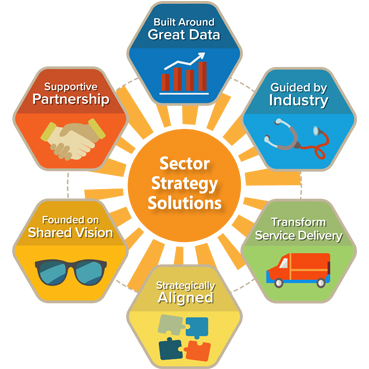
What are Sector Strategies?
Sector Strategies Toolkit
The Road to Successful Sector Partnerships

Convener initiates the work
The Convener should be a trusted leader that has credibility with industry and other partners. The convener may be workforce, economic development or another partner. The impetus for starting this process is often a challenge. For example, the convener may already know that a particular regional industry is facing significant workforce challenges, or, more broadly, the convener may be concerned that area partners are not active enough in meeting the workforce and other needs of key industries in the region.
In other cases, a business may approach the convener with a problem for which it needs assistance. Note that the initial convener may not lead throughout the entire process.
The convener gathers and analyzes available data to understand the regional industry landscape and begin to identify potential trends and needs which may be across industries region-wide, or in a particular industry of focus. The data reviewed may be both quantitative and qualitative or anecdotal. The goal of this initial data review is to understand the key industries in the region; factors such as employment size, growth, and concentration; critical occupations in the industries; and industry trends and potential pain points.

Convener pulls public partners together to form the initial partnership
Partners should include workforce partners and the full spectrum of education partners, K-12 to post-secondary, as well as economic development partners who typically already have relationships with current employers and may have access to different funding streams, and others.
The convener determines who else needs to be at the table and engages them to leverage all resources to meet the needs of business in the targeted sector. Conveners should:
- Leverage and integrate with existing regional industry partnerships if they already exist; don’t recreate the wheel.
- Work with partners to establish the initial vision and confirm partners’ willingness to align their efforts and resources to support the partnership. This commitment can be formalized through the development of a charter that is initially signed by public partners followed by business partner signatures when they join.
- Work with partners to agree on how they will interact with business. Ideally, the partnership will establish the convener as the face of the public partnership who meets directly with business and communicates industry needs back to the other public partners.
- Collaboratively develop initial measures for the desired outcomes of the sector work early, to be validated and refined with employers shortly. Measures regarding meeting the needs of the targeted industry and workers as well as system change should be identified. A system for tracking and reporting progress toward meeting those goals also is needed to ensure accountability and transparency.

Collect, aggregate and review data
The convener asks partners to bring data for analysis and discussion. The partnership may consider forming a data team with representatives from each partner to present their own data and bring the group to a consensus regarding what all data mean when viewed collectively. This stage of data review should include a more in-depth analysis of key occupations across the industry, current openings, projected growth and contraction, wage levels, and other factors. The goal is to develop an understanding of the current and projected state of the industry and its key workforce dynamics and potential needs.
Once the data is aggregated and reviewed, the team should make it presentation-ready for discussion with businesses. Note that presentation-ready is not a data dump; it is data connected in such a way as to tell an industry-specific story. Determine the initial target industry based on a variety of factors, such as data, available resources, needs, low-hanging fruit opportunities, which industry already is a champion, which industries are asking for help, etc.

Engage targeted businesses
The convener – or another partner if better positioned – engages businesses in the target industry for an initial conversation on workforce trends, challenges and needs. If possible, the convener seeks to leverage an identified business champion to engage other businesses in refining and validating data and joining the partnership and process.
The convener or business champion needs to clearly articulate the value proposition, goals, level of commitment and return on investment to the businesses. The partnership then validates and refines initial outcome measures and accountability/reporting plans with industry partners. If a charter is in place, it could be updated with this information and signatures of the industry partners.

Reconvene partners to share initial industry input
Typically, it is not ideal to have all partners at the table with business. It is critical to safeguard business’ time and commitment by ensuring that communication is streamlined and strategic. They do not need to see the “sausage making” that happens when public partners work to align their policies, programs and resources but, rather, a single unified message from the partnership.
As noted in Step 2, “Convener pulls public partners together to form the initial partnership,” there may be a need to establish a separate process for communicating industry input with all public partners especially as industry relationship deepens. Note also that industry input and needs may change or expand the partners needed within the partnership. Revisit, refine as necessary, and note that defining and reconfirming partners’ commitments is an ongoing process.

Ongoing, deepening partnership conversations continue
The partnership further analyzes data, specific workforce gaps and needs, career pathways, etc., by engaging in two key activities with industry and other partners:
- Industry talent needs assessment with business.
- SWOT and regional capacity and gap analysis with public partners – this is where career pathways development starts.

Identify and validate strategies to meet sector partnership talent needs and address gaps
The identified strategies could require stopping or changing what’s already occurring or starting something new or entirely different. Strategies may span from the high level (e.g. policy and funding investments) to the ground level (e.g. changes or enhancements to service delivery). Public partners must be willing to adapt based on business needs and align their strategies to create a cohesive system.

Develop an implementation plan
The partnership collaboratively develops a plan for implementing the strategies that is intentional about tasks, measures, accountability and sustainability. Key components include:
Key components include:
- Action steps, responsible parties and timelines for each strategy.
- Funding and other resources that will support strategies.
- Other needs such as policy and staffing to support implementation of the strategies.
- Measures and metrics that will be tracked during implementation for ongoing assessment, public reporting and continuous improvement purposes.
- A sustainability plan.

Implement strategies and track implementation
The partnership should engage in an ongoing assessment of efforts to ensure they stay relevant to changing industry needs; remain necessary, as some activities may need to stop once they are no longer needed; and have the intended impact.
To maintain an ongoing focus on continuous improvement, it is critical that the partnership:
- Maintains an open and continuous communication loop with the sector partners (business and public) and share business feedback with public partners for follow up.
- Track and report on performance against metrics to ensure transparency and refinement of approaches as needed.
- Meet regularly to discuss performance, evaluate changing needs, and initiate new or modified strategies.

